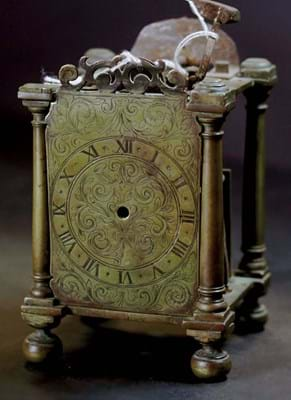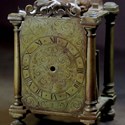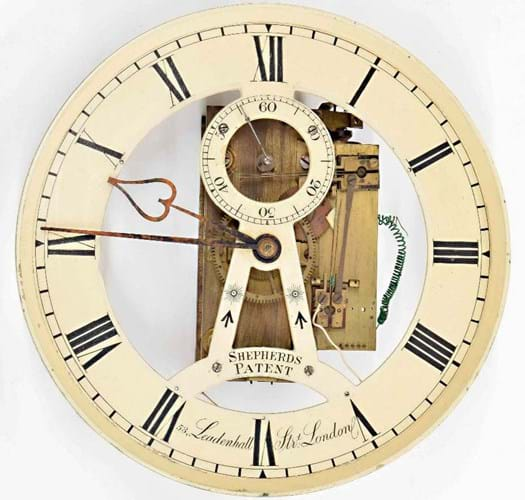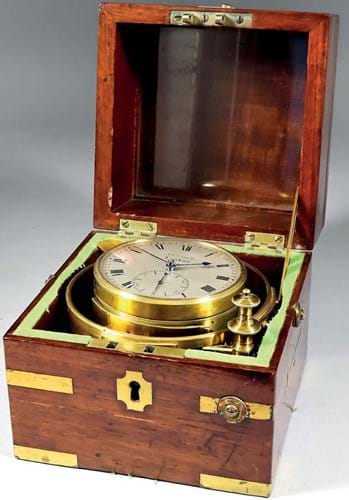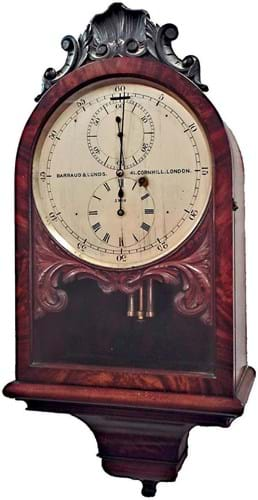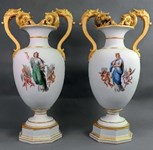“It was in terrible condition,” said auctioneer Michael Roberts. “It lacked a hand, a bell and three side panels, the rear spikes had been hacked off, the innards were rusted and it appeared to have been crudely adapted.
“I had it on my desk for three months before I decided to put a token £100-150 estimate on it and leave it to the market.”
Interest picked up a few days before the February 19 sale at Skirsgill.
Many elements of this relic, including a single-piece, engraved dial and muscular columns were indicative of a First Period (pre English Civil War) clock and one that was possibly as early as 1600.
Bidders seemed to agree. Contested by four on the phone and three online, the clock sold at £9000 a Yorkshire buyer who intends to restore it for his private museum.
A more straightforward success at the sale was an ‘Act of Parliament’ or tavern clock by the highly regarded and prolific maker William Mayhew of Woodbridge (1725-91).
It was signed below the dial and the 5ft 1in (1.55m) tall black lacquered chinoiserie case enclosed an eight-day, four-train movement with royal pendulum. It sold right on the mid-estimate at £7000.
Slave clock
Made three centuries after the lantern clock, another rare timepiece was identified at the Gardiner Houlgate (20% buyer’s premium) horology sale in Corsham on February 20.
This was an electric slave clock signed to the 12½in (32cm) diameter cream skeletal dial Shepherds Patent Leadenhall Str London.
Slave clocks – essentially dials controlled by electrical impulses from a master regulator to ensure all registered the same time – emerged in the 19th century and were widely used during most of the 20th century.
This example came from a private collection which is being dispersed in tranches at the Wiltshire rooms. Previous sales include a £10,500 master clock by William Hamilton- Shortt last May (ATG No 2396).
Shepherd’s distinguished founder, Charles Shepherd (1830- 1905), was an early pioneer of electric clocks and installed the network at the Royal Observatory, Greenwich, in 1852.
The 24-hour Shepherd Gate Clock is thought to be the first to display Greenwich Mean Time to the public.
The clock at Corsham was probably produced in the 1930s. Nevertheless, auctioneer Jamie Southgate believes it was the first of its type to come up for auction.
Against a tempting £300-500 estimate, it attracted wide interest before it sold to a Continental collector at £5800.
Best of the traditional timepieces at Corsham was a basket-top table clock signed to the finely engraved backplate Nathaniel Hodges in Wine Office Court Fleet Street London fecit, a maker whose known period is given as 1680-1700.
The 14in (35cm) tall ebonised case enclosed a single-fusee five-pillar movement which had been altered from verge escapement to anchor in Victorian times. It came from a deceased estate with a here-to-sell £1500-2500 estimate, but the clock went to £5200. The buyer was a top-end dealer who will be able to undertake the necessary work on both movement and case.
Chronometer in Canterbury
From the days when ships’ captains still set their chronometers by the falling ball at Greenwich, a c.1825 brass-bound mahogany one-day chronometer sold at Canterbury Auction Galleries (20% buyer’s premium) on February 8.
It was signed to the backplate for the celebrated John Arnold – Jno. R. Arnold, London Inv. Et Fecit. No 568 – it had a fusee movement with maintaining power and a patent bi-metallic balance. Housed in a 5¾in (14.5cm) square mahogany double-opening case, it went to a North American buyer at £4000 (estimate £1500-2000).
Busy lines
The market for good-quality 19th century clocks generally – apart from longcases – remains strong, as shown at Wotton Auction Rooms (18% buyer’s premium). A 19th century single fusee, regulator wall clock by Barraud & Lunds of 41 Cornhill, London, was the outstanding lot.
Part of a consignment from a modest Bristol house, the 2ft 4in (68cm) high clock pitched at £300-400 was the top estimate among the 32 clocks on offer at the Wotton- Under-Edge, Gloucestershire, saleroom on February 25-26.
The auction house commented: “With more than 80 watchers on thesaleroom.com and six phone bidders, we had more requests for telephone bids then we have staff.”
Offered with pendulum and key, it sold to a UK online buyer via thesaleroom.com at £4600.


